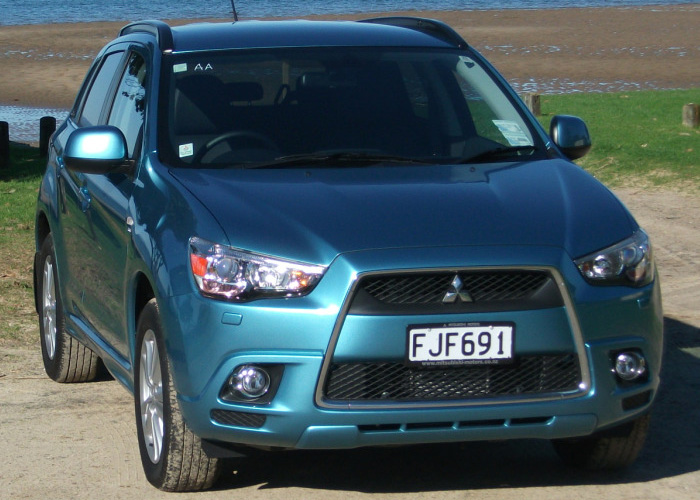
Car reviews
Read our expert car reviews - where we give insight into the latest vehicles to hit our roads.
09 February 2011
Like others launched in 2010, Mitsubishi’s new ASX is offered in two wheel drive, four wheel drive, petrol and diesel, with the only disappointment being that the diesel only comes with a manual transmission.

It’s been a year of small CUV’s, with every car manufacturer seeming to climb on the band wagon of this rapidly increasing market sector.
Like others launched in 2010, Mitsubishi’s new ASX is offered in two wheel drive, four wheel drive, petrol and diesel, with the only disappointment being that the diesel only comes with a namual transmission, so we’re betting that sales will be dominated by petrol versions with the CVT auto.
Mitsubishi is aiming the ASX squarely at the urban buyer with their “Street Smart” campaign, reasoning that the CUV is rapidly taking over from the mid-size saloon and hatch sector, and market research telling them that aging city-dwelling baby boomers make up a high percentage of competitor product purchases.
Pleasing on the eye, the ASX is conservative and nothing radical, but the lines flow well and styling is clean and contemporary. The Evo-style “Jet-fighter” front grille treatment that has become a familiar Mitsubishi family trait works well on the ASX and gives it a sense of belonging.
The 2.0 litre petrol powered ASX is offered in two grades of trim, LS and Sport, and both are offered in 2WD and 4WD. The diesel comes in Sport only and is the only model to have leather seats as standard.
Power output from the 2.0 litre MIVEC petrol engine is 112kW, and 200Nm of torque is produced. 2WD models achieve a fuel consumption figure of 7.9L/100km and produce 184g/km of CO2, while 4WD versions consume a little more at 8.1L/100km and 188g/km of CO2.
All petrol models are offered with a CVT automatic transmission with six manual shift steps. Sport models introduce paddle shift for the manual operation.
The 1.8 litre diesel engine offers similar power, at 112kW, but raises the torque output to 305Nm. Diesel fuel is consumed at the rate of 5.9L/100km, with 155g/km CO2 emission. The manual ‘box mated to the diesel engine has six forward ratios.
All models offer the full array of safety equipment including Active Stability Control, ISOFIX and seven airbags including a driver’s knee airbag. Recent ANCAP testing awarded the ASX a 5 star safety rating.
Sport models come with backing sensors, keyless one touch start system, Bluetooth, headlamp washers, rain sensing wipers, front fog lights, audio controls on steering wheel and 16 inch alloy wheels on petrol versions, 17’s on the diesel.
LS models are fitted with 16 inch steel wheels and are identified with black, rather than chrome grille and belt line mouldings. All 4WD models have roof rails and tilt and telescopic steering wheel adjustment is standard across the range, which is a feature not seen on Mitsubishi product for over 20 years since the 1988 Lancer.
Front guards are manufactured from a composite plastic material, having the benefit of springing back into shape on minor impacts as well as offering an all important weight saving. Only 3.5kg in this case, but every little helps.
The interior is nothing flashy but perfectly functional and easy to find your way around. It’s plenty roomy enough with a decent amount of loading space in the rear.
Like all its competitors, it’s easy to get in and out of, with the ASX having excellent all round visibility, and is better than many competitors in this regard. Ride is fairly soft and compliant and Mitsubishi tell us they’ve paid a great deal of attention to sound insulation, something they’ve achieved admirably.
On the open road, noise is kept to a minimum, and while it’s fairly softly sprung so doesn’t like being chucked too hard through corners, it was never designed to be a sports car and offers a comfortable ride when used as intended.
For those with a need for heavy towing, the ASX isn’t for you, with a braked towing capacity of just 1,050kg, but it’s more than adequate for dragging a trailer load of garden waste to the tip.
Competing in an increasingly heavily populated sector, Mitsubishi have keenly priced the ASX, starting under the entry level Nissan Qashqai by a few hundred dollars and several thousand beneath the Hyundai ix35.
Priced from $35,490 through to $45,990, the ASX is likely to give Mitsubishi’s sales volume the lift they're looking for in New Zealand.